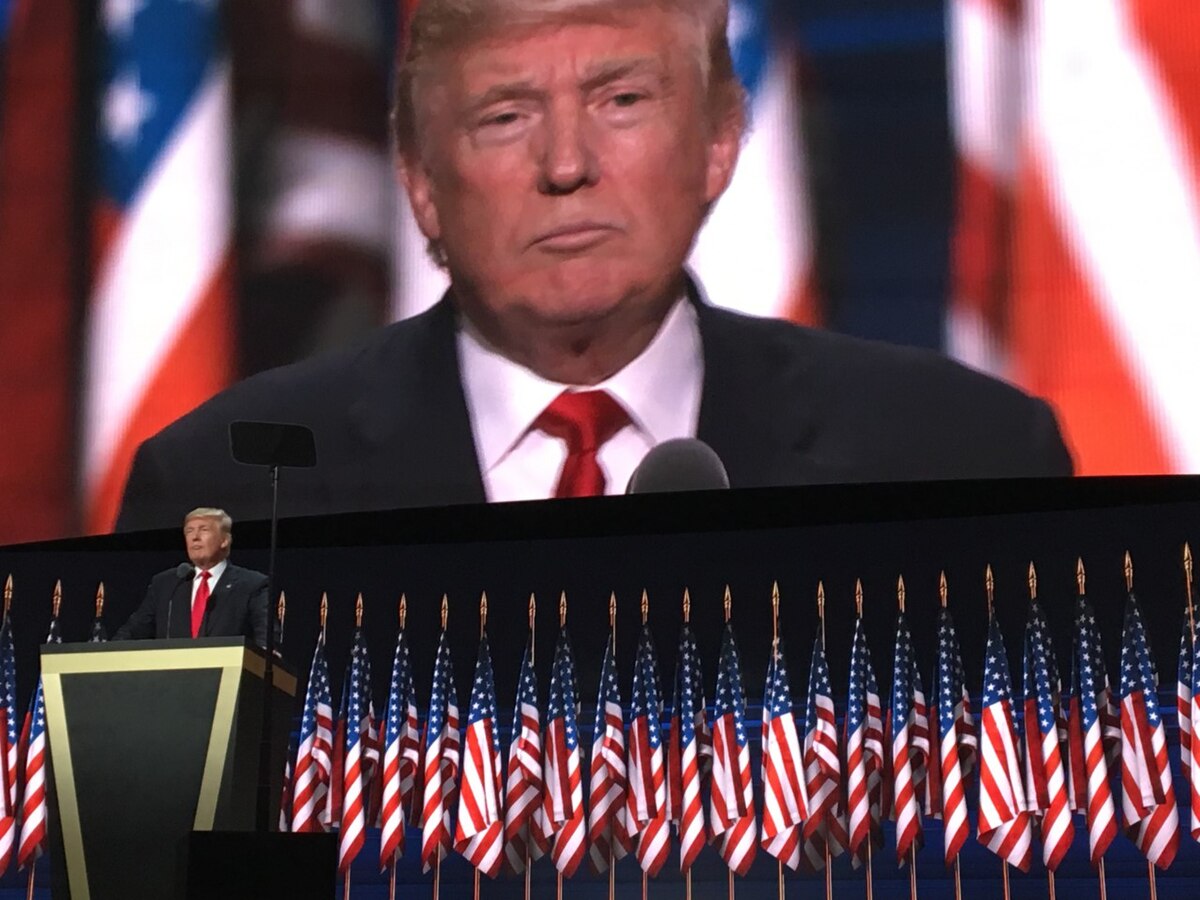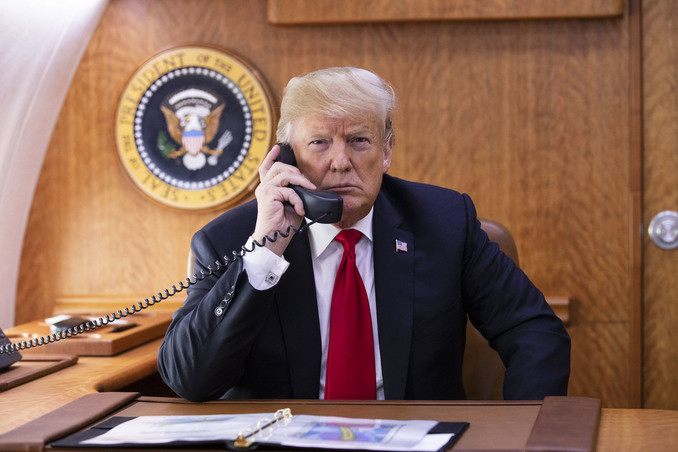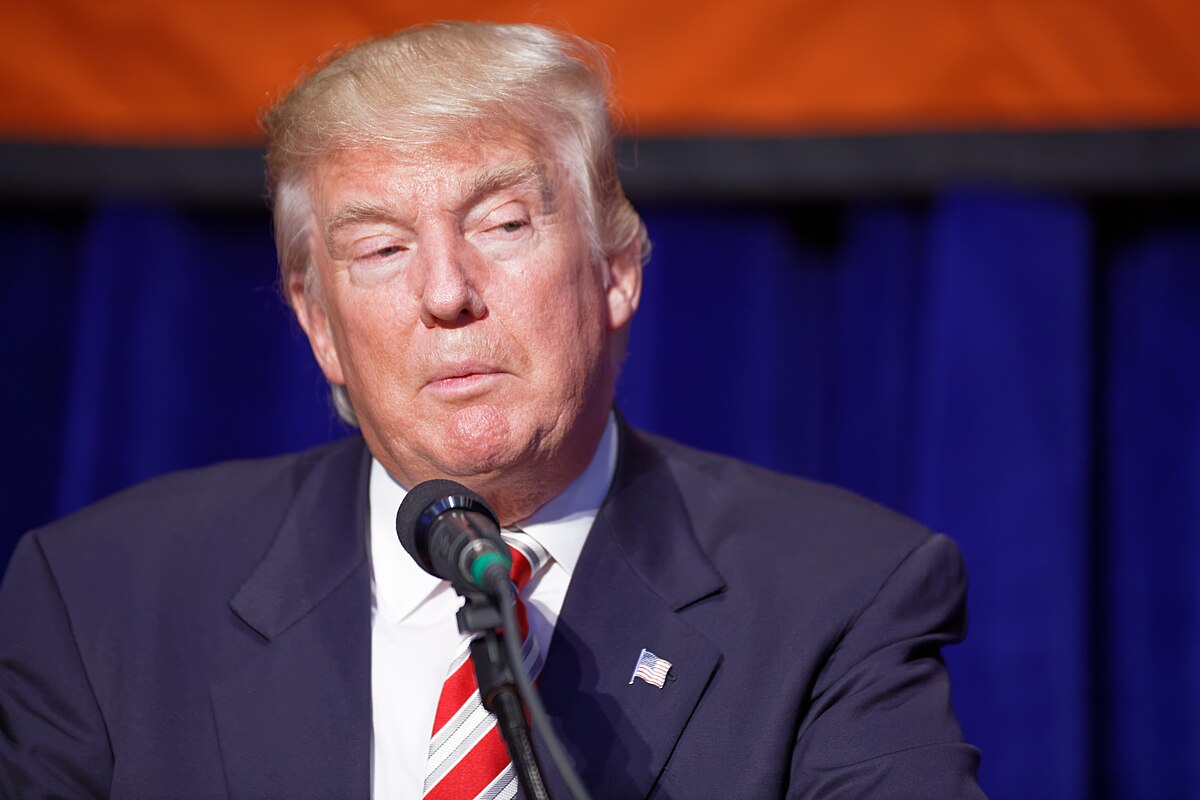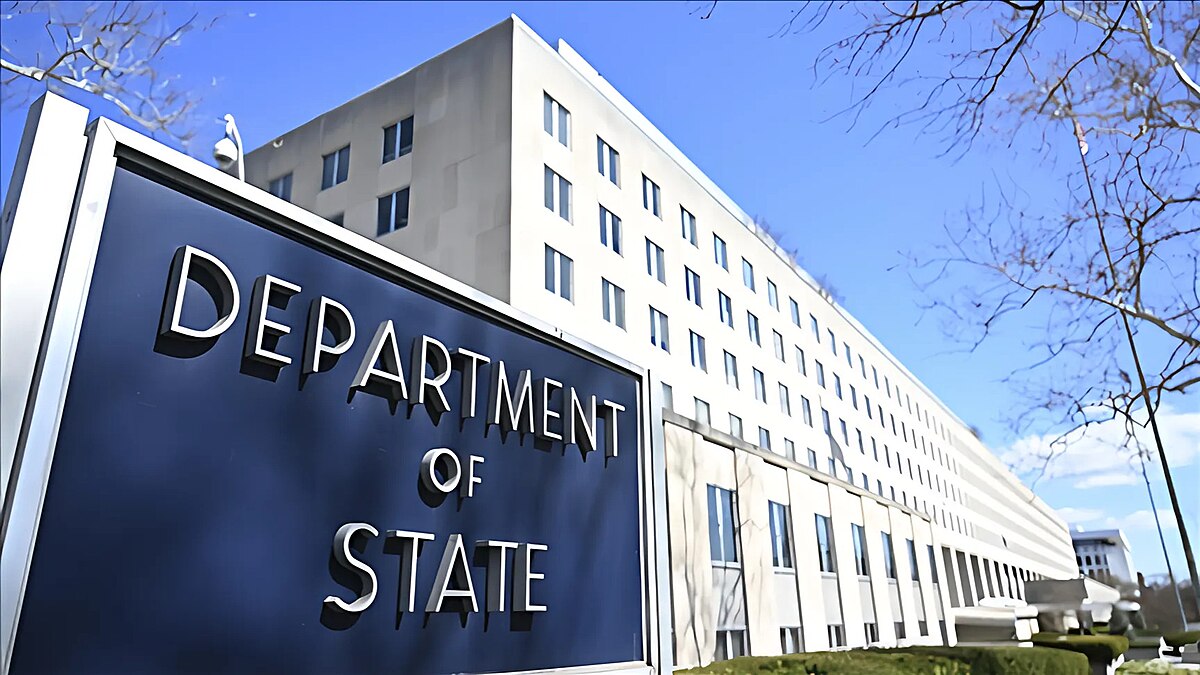- 14 3402-5578
- Rua Hygino Muzy Filho, 737, MARÍLIA - SP
- contato@latinoobservatory.org
 Nicolas Pinault, Voice of America
Nicolas Pinault, Voice of America
The Trump administration's immigration policy has become one of the central pillars of its governmental and electoral strategy, articulating repressive mechanisms and security discourses to build political legitimacy. Several studies indicate that, since the first term, immigration has been treated not only as an administrative issue, but as an instrument of electoral mobilization, especially among conservative segments that associate migration with economic and criminal threats.
Some measures, such as the expansion of detentions by U.S. Immigration and Customs Enforcement (ICE), the reestablishment of expedited deportations, and the deployment of federal troops to the so-called "sanctuary cities," exemplify this movement. Articles from the Associated Press and CBS News show that, in recent months, the federal Executive has intensified operations in states governed by Democrats, generating conflicts with local authorities and opening legal disputes over the constitutionality of these interventions. Furthermore, human rights activists have documented the separation of families, the summary deportation of asylum seekers, and reports of prolonged detentions in degrading conditions - direct impacts of immigration policy driven by the logic of punitive deterrence.
We assess that, from a discursive point of view, the government mobilizes narratives based on fear and insecurity. It is observed that, in official pronouncements, Trump and members of his cabinet associate immigrants with increased crime and terrorism, even when federal data does not corroborate this relationship. Published research from institutes and corporations, such as the FBI and the Cato Institute (2023–2025) indicates that immigrants, documented or not, do not have higher rates of involvement in violent crimes when compared to native-born citizens. Even so, the security discourse produces a public imaginary favorable to government hardening in immigration processes.
Therefore, the central problem is not limited to the legal content of immigration policies, but to the way in which the Trump administration has instrumentalized migration under the state apparatus as a political resource, reinforcing exclusionary national identities and producing concrete effects on the lives of refugees, asylum seekers, and Latin American communities established in the United States. Current immigration policy has transformed vulnerable populations into symbolic capital, as conceived by Pierre Bourdieu, since it converts human suffering into electoral benefit and political power.
In this analysis,
we start from the central hypothesis that the current immigration policy of the
United States combines state repression and political calculation, converting
the border security agenda into an instrument of electoral mobilization. The government
constructs a narrative that associates immigration with crime and disorder,
even though empirical data does not confirm such a correlation. Another recent
report from the Pew Research Center shows that 73% of
Republicans and Republican-leaning independents classify illegal immigration as
a very significant problem for the nation. This
statement coincides with periods of intensified rhetoric from the Executive
branch, especially during times of voting on legislative packages and regional
election cycles. The expansion of ICE's operational actions and the adoption of
expedited deportation mechanisms were accompanied by a significant increase in
detentions. These elements support the hypothesis that immigration policy
serves a dual purpose: on the one hand, to increase the state's repressive
capacity over migrant populations; on the other, to produce political gains by
mobilizing fear as a public language, reinforcing symbolic and identity-based
boundaries between "nationals" and "foreigners."
Immigration policy thus becomes both a disciplinary practice and a resource for
electoral legitimation, a hallmark and strength of the Trump 2.0
administration.
2
HISTORICAL AND POLITICAL CONTEXTS
In the United States, the Posse Comitatus Act (PCA), passed in 1878, prohibits the use of the Army or the Armed Forces for civil law enforcement functions. The name of this law comes from the concept of posse comitatus, or "county power," which is the authority of a sheriff to summon citizens to help him maintain peace and enforce the law. This law was enacted to limit the federal army in the application of domestic police functions after the use of the Army for law enforcement following the American Civil War, in response to abuses committed during Reconstruction. Originally it applied only to the Army, being extended to include the Air Force in 1956, followed by the Navy, the Marine Corps, and the Space Force in 2021.
However, the "Insurrection Act of 1807" provides for some circumstances in which the use of the Armed Forces on American soil is permitted, being one of the few exceptions to the Posse Comitatus Act. It allows the president to use the Armed Forces to restore order, ensure the enforcement of laws, and protect civil rights. The main circumstances provided for in this law are: a) when a governor or state legislature requests federal assistance to suppress an insurrection, riot, or disturbance that the state cannot control alone. An example would be the case of the "Detroit Riots" (1967), in which federal troops were sent after a request from the governor of Michigan. The “Detroit Riot” was sparked by a police raid on a speakeasy in the first hours of July 23, 1967, in a predominantly Black neighborhood. Furthermore, the fuel for the confrontation was a combination of racism, police brutality, and widespread poverty experienced at the time.
In this sense, without the state's consent, in cases of obstruction of federal law, if the application of federal laws is impeded and local authorities are unable to restore order, the president can act even without the state's request if there is: 1) insurrection against the federal government; 2) obstruction of the execution of US laws; 3) situations that make it impossible to apply the law by normal means. An example of this case would be the “Little Rock Crisis” (1957), when nine Black students, the “Little Rock Nine,” attempted to enroll in the then-segregated Central High School in Little Rock, Arkansas, after the Supreme Court decision in Brown v. Board of Education, which ruled that segregating children in public schools based on their race or ethnicity was unconstitutional. The conflict escalated when the state governor blocked the students' entry, leading then-President Dwight D. Eisenhower to send federal troops to protect them and ensure the proper enforcement of the law.
Finally, 4) to protect civil and constitutional rights when they are denied and state authorities fail to take measures to protect their citizens. This clause was used during the Civil Rights Movement in the 1950s and 1960s, which fought against racial segregation and discrimination, primarily against African Americans, whose main objective was to end legalized segregation, discrimination, and deprivation of due rights affecting African Americans.
The preceding episodes illustrate how, although the Posse Comitatus
Act restricts military employment in police tasks, recourse to the Insurrection
Act or specific exceptions has historically been used in situations
considered emergencies or serious disruptions of public order.
During Donald Trump's first term (2017-2021), immigration was treated, from the campaign onwards, not only as an economic or humanitarian issue, but as a matter of national security. This approach aimed at securitizing immigration, framing it as a clear threat to sovereignty, internal security, and American identity. Early in his first term, on January 25, 2017, Trump signed Executive Order 13767, "Border Security and Immigration Enforcement Improvements," which established that "border security is critically important" and that immigrants who entered illegally or remained after their visas were considered a "threatto national and public security". Thus, the first Trump administration prioritized the removal of non-citizens, including those without a criminal record, which represented a change compared to previous periods.
Regarding “sanctuary cities” (jurisdictions that limit cooperation with federal immigration agents), Trump's policy sought to punish these jurisdictions by conditioning or withdrawing their federal funding or pressuring them to cooperate. With the transformation of immigration into a matter of national security, emphasizing control and removal at the expense of integration or rights, Trump's policy aimed to punish these jurisdictions by conditioning or withdrawing their federal funding. Regarding immigrants, the discourse that Trump has been using, as observed earlier, is based on the association between irregular immigration and crime or insecurity and, in this sense, that "sanctuary" jurisdictions would be protecting foreign criminals. Given this logic, cities that refused to cooperate with federal agents or to honor ICE immigration detainers became symbolic and concrete targets of federal policy, generating tensions with local governments.
In Trump's first term (2017-21), the emphasis was on immigration and sanctuary cities: expansion of interior enforcement, funding constraints, security rhetoric, but less explicit large-scale mobilization of federal troops in sanctuary cities. It is worth highlighting that, during the first term, there was no reported massive mobilization of federal troops for urban policing in "sanctuary cities" on the same scale as what might be suggested for 2025. However, there was strong rhetoric, interior enforcement operations, and legal and political threats of varying conduct and levels. In its new phase, under the Trump II administration, we believe this agenda is gaining new momentum, with renewed federal pressure on sanctuary cities and indications of federal force or troop mobilization in urban contexts, raising the debate to the intersection of security, legality (domestic militarization), and human rights.
The Trump administration signed an executive order on April 28, 2025, to
"crack down" sanctuary cities, conditioning funding, requiring
lists of non-cooperative jurisdictions, notifications to the Department of
Homeland Security (DHS) and Department of Justice (DOJ), among other
controversial actions. Simultaneously, there
are reports of the mobilization or threat of mobilization of National Guard
troops in urban jurisdictions where protests or immigration operations are
expected. Cities like Portland, Oregon, and Los Angeles are mentioned in recent
news reports. In 2025, the DHS and
the DOJ identified and exposed “sanctuary jurisdictions” that, according to the
government, obstruct the enforcement of federal immigration law, stating in
their press release that “sanctuary cities protect illegal immigrants and dangerous
criminals, shielding them from consequences and placing law enforcement in
grave danger,” and also presents a complete list of cities considered
sanctuaries.
3 LEGAL FRAMEWORK AND PRESIDENTIAL AUTHORITY
The discussion about sending federal troops to sanctuary cities requires understanding the normative framework that delimits and, at the same time, enables the use of military and paramilitary forces on national soil. The central legal framework for this debate is the Posse Comitatus Act (1878), which, as previously presented, restricts the use of the Armed Forces in the application of domestic law. However, US legislation combines prohibitions, exceptions, and conditional permissions, creating an ambiguous regime that allows for expansive interpretations by the Executive, especially during periods of political conflict or security demands.
In the case of the Trump administration, the legal arguments used to justify sending federal troops or the National Guard have relied primarily on three legal instruments: the Posse Comitatus Act, the Insurrection Act (1807), and the National Guard mobilization regime under Titles 10 and 32 of the U.S. Code. These provisions are supplemented by recent memoranda and executive orders, such as the Presidential Memorandum of June 7, 2025, which authorizes the Department of Defense to support the Department of Homeland Security in “protecting federal facilities and personnel”.
The Posse Comitatus Act establishes restrictions on the use of the Army and Air Force as a domestic police force. However, this limitation is not absolute. The main historical exception is the Insurrection Act (1807), which allows the president to: act at the request of state governments; without the consent of the states, when there is revolt, obstruction of the enforcement of federal laws, or threat to civil rights; protect federal property and ensure the enforcement of the law. This last clause became the central legal basis in 2025. The Memorandum of June 7, 2025, maintains that the Armed Forces can provide security to DHS facilities and agents, which creates room for military action in urban areas linked to immigration operations. Within the framework of Title 10 vs. Title 32, the most visible controversy revolves around the National Guard, because under Title 32 the troops remain under the command of the governors, while under Title 10, the troops are federalized and come under the direct command of the President. This distinction gains practical relevance in episodes of internal security, borders, and public order, and has been the subject of political and constitutional controversy. The debate intensified during the 2020 national protests, sparked by the death of George Floyd and marked by mobilizations against police violence and systemic racism. Several states mobilized their National Guard units under Title 32, while the federal government signaled the possibility of federalization under Title 10, generating disputes between presidential authority and state autonomy. In Washington, D.C., the action took place under direct federal authority, since the territory does not have a governor, which raised questions about transparency and limits on the use of the military in typical policing activities.
These episodes demonstrate that, although the legal framework is relatively clear, its application has produced recurring tensions between federal and state powers, as well as legal debates about scope, proportionality, and civilian control.
In the case of the Trump administration, the legal arguments used to justify sending federal troops or the National Guard have relied mainly on three legal instruments: the Posse Comitatus Act, the Insurrection Act (1807), and the National Guard mobilization regime under Title 10 and Title 32 of the U.S. Code. In addition to these provisions, there are recent memoranda and executive orders, such as the Presidential Memorandum of June 7, 2025, which authorizes the Department of Defense to support the Department of Homeland Security in “protecting federal facilities and personnel”.
In this context, governors of states such as California, Oregon, and
Illinois refused to make their troops available for immigration operations. In
response, the federal government sought the compulsory federalization of state
units, generating litigation such as Illinois vs. Trump and California vs.Trump.
4. IMPACTS ON HUMAN
RIGHTS AND PUBLIC SECURITY
The intensification of immigration policies under the Trump II administration, especially after 2025, has generated concrete effects on human rights, public security, and social cohesion in jurisdictions classified as "sanctuary cities". Repressive measures create a high-risk scenario for civil rights and fundamental freedoms. In several states, human rights organizations and public defenders have reported episodes of arbitrary detentions, nighttime operations conducted by federal agents, and electronic monitoring of migrant advocacy groups and community leaders. The overlap between immigration and national security apparatuses contributes to a diffuse criminalization of the immigrant presence, which is treated as a potential threat rather than a social or humanitarian issue.
In terms of civil rights, the use of federal troops and National Guard forces in immigration control activities raises concerns about the proportionality and legality of the actions. Field reports and press records (Los Angeles leaders impose curfew as protests against Trump's immigration crackdown continue | The Associated Press) indicate the use of dispersal tactics typical of military contexts, such as tear gas, stun grenades, and preventive detentions, during peaceful demonstrations in cities like Portland, Los Angeles, and Chicago. Such practices constitute potential violations of the First Amendment of the U.S. Constitution, which guarantees the right to free speech and assembly, and call into question the principle of civilian control over security forces. The monitoring of activists and journalists through intelligence programs, in the name of "border security," increases the risk of political surveillance and intimidation of dissidents.
This phenomenon produces particularly important and worrying social effects on immigrant and refugee communities. The constant presence of ICE agents and federal units in neighborhoods with high concentrations of immigrants has provoked widespread fear and a retraction of public life. Several local organizations report a sharp drop in the number of crime reports, especially cases of domestic violence, trafficking, and labor exploitation, because victims and witnesses fear being detained or deported when interacting with authorities. Based on existing reports, it is assessed that this phenomenon of "underreporting due to fear" compromises public safety and breaks ties of trust between the population and institutions. In addition, there are records of internal displacement of families who abandon cities targeted by federal operations to seek refuge in smaller towns or in other states, without guaranteed legal protection, reinforcing the socioeconomic vulnerability of these communities (Como pressão de Trump sobre 'cidades-santuário' pode afetar brasileiros nos EUA? - BBC News Brasil).
There is also the perspective of local security policies, as the presence of federal forces has produced significant institutional tensions. Mayors and police chiefs in several sanctuary cities, such as San Francisco, Seattle, and Boston, argue that federal interference undermines community policing strategies built up over decades. The local model, historically focused on prevention and social cooperation, depends on the trust of communities, which is eroded by the association between public agents and deportation coupled with violence. Thus, the imposition of a logic of "national security" in urban security contexts alters the federal balance and hinders the implementation of integration and reception policies. There are also reports that many police departments even report difficulty in recruiting bilingual agents and a loss of legitimacy among immigrant populations, who begin to avoid any institutional contact.
In this sense, the impact on human rights is not limited to direct violations but is also expressed on a symbolic and discursive level. Presidential rhetoric that associates immigration with criminality reinforces racial and ethnic stigmas, legitimizing practices of discrimination and social hostility. Documented cases of assaults and hate crimes against Latin Americans and Muslims have increased in parallel with peaks in the Executive's rhetorical intensification, according to preliminary FBI data from 2024–2025 (Hate Crimes | Facts and Statistics). Thus, official discourse operates as a catalyst for exclusionary social behaviors and the naturalization of institutional violence, reproducing the cycle of fear and repression that sustains the migration agenda itself.
Overall, interdependence is observed between immigration policy and the degradation of public security. The federal apparatus, conceived under the logic of punitive deterrence, weakens local prevention and mediation capacities, replacing citizenship policies with containment strategies. Mass detention and deportation measures not only produce trauma and family breakdown but also overburden local courts and social services. The result is an environment of heightened insecurity, in which both immigrants and US citizens are affected by a culture of permanent surveillance and exception.
In short, the impacts on human rights and public safety resulting from
the current immigration policy reveal a paradox: in the name of security,
practices that undermine the very democratic and legal foundations of the state
are expanded. The criminalization of migration and the militarization of the
internal management of public order generate a cycle of institutional erosion
and lasting social insecurity, the cost of which falls primarily on the most
vulnerable populations, but whose implications reach the entire American
democratic fabric.
5 POLITICAL AND LEGAL REACTIONS
The Trump administration's offensive against so-called "sanctuary cities" has triggered a chain of political and judicial reactions that articulate tensions between levels of government, constitutional interpretations, and civil society mobilizations. Several governors and mayors of jurisdictions targeted by the immigration policy have publicly rejected federal interference, announcing their refusal to cooperate with ICE operations or even threatening legal sanctions. The position of these local administrations is based, in part, on the argument that the effects of "automatic cooperation" with ICE would undermine the trust of immigrant communities in local police, reducing communication between immigrants and local authorities and compromising overall public safety. In some cases, the governor of the corresponding state has also expressed objection. A significant example: Minnesota Governor Tim Walz described the DOJ's demands as "some kind of misguided political agenda" and "fundamentally incompatible with our founding principles as a nation".
These political reactions reveal the logic of local resistance that seeks to preserve municipal or state autonomy in the face of federal power, while also exposing the mobilizing nature of the immigration issue, not only as administrative policy but also as a symbolic dispute in the electoral field.
The federal judiciary has played a central role in mediating the crisis between the federal government and local jurisdictions. One of the most important decisions occurred on April 24, 2025, when Judge William H. Orrick III of the San Francisco District Court granted an injunction prohibiting the Trump administration from withholding or conditioning federal funding to cities and counties based on their “sanctuary” policies. He considered, among other reasons, that such threats caused irreparable harm, such as budgetary uncertainty, violation of constitutional rights, and undermined trust between local government and the community. Subsequently, in August 2025, the same judge expanded his order to cover 34 additional jurisdictions (including, for example, Los Angeles, Chicago, Boston, Denver) preventing cuts in federal funding. Furthermore, in September 2025, the state of Oregon and the city of Portland filed a lawsuit against the Trump administration regarding the mobilization of federal troops, specifically the National Guard, in local territory. Judge Karin Immergut granted an injunction around October 4, 2025, preventing the deployment of these troops on the grounds of non-compliance with the Guard's activation requirements.
Alongside institutional mobilization, the role of non-governmental organizations, civil rights advocacy groups, and community-based networks has been significant, both in collective litigation and in monitoring federal operations and denouncing violations.
Grassroots groups have documented operations involving mass detentions and the use of force or military and federal units in localities where "sanctuary city" status was claimed.
The reaction to the Trump administration's policy on
"sanctuary cities" reveals a scenario in which the federal state
mobilizes coercive mechanisms (judicial, financial, operational) and faces a
combined response from subnational levels, the judiciary, and civil society. It is observed that this triad
operates as a counterpoint to the attempt to instrumentalize migration as a
resource for governance and electoral mobilization.
6 FINAL CONSIDERATIONS
This analysis has shown that the immigration policy of the Trump II administration has consolidated itself as an instrument of political power, sustained by a rhetoric of fear and the expansion of the state's repressive apparatus. Federal actions directed against so-called "sanctuary cities," including the mobilization of National Guard troops and the conditioning of resource transfers, reveal a strategy of confrontation between levels of government and an expansion of executive authority in areas traditionally reserved for state and municipal autonomy.
From a legal standpoint, we have observed the flexible use of provisions such as the Posse Comitatus Act, the Insurrection Act, and Titles 10 and 32 of the U.S. Code to justify the use of federal forces on domestic soil. This practice, although supported by extensive legal interpretations, raises questions about its constitutionality and about the limits of civilian control over military action. We believe that recent court decisions, such as the injunctions granted by the federal courts of San Francisco and Portland, demonstrate the relevance of the judicial system as a mean of restraint against potentially abusive initiatives by the Executive branch.
In terms of human rights, the findings point to a scenario of institutional erosion and deterioration of civil guarantees, marked by arbitrary detentions, family separations, excessive use of force, and political surveillance. The policy of punitive deterrence and security discourse has produced effects of fear and social withdrawal among immigrants, compromising public safety and trust in institutions. By associating immigration with crime, we understand that the government contributes to the legitimization of discriminatory practices and to the increase in social hostility against racialized groups.
In summary, we believe that the current immigration policy combines administrative repression, expansion of presidential power, and electoral instrumentalization of the immigration issue, producing profound impacts on the rule of law and democratic cohesion. The formal legality of these measures does not eliminate their material illegitimacy considering international standards for the protection of human rights and the constitutional norms governing the separation of powers in the United States.
Given this context, it is recommended that researchers expand empirical
studies on the local effects of migration operations and on mechanisms of
institutional and community resistance. To policymakers, we point out the need
to strengthen judicial monitoring mechanisms, instruments of transparency and
civil control over security forces, and intergovernmental dialogue structures
capable of preserving the federal balance. Finally, local actors and civil
society organizations should be encouraged to maintain civil rights protection
networks and channels of legal and humanitarian cooperation that ensure the
monitoring of violations and the defense of affected populations.
The consolidation of a migration policy compatible with the democratic
rule of law therefore depends on the reconstruction of institutional bridges
between security, legality, and human dignity, dimensions that, under the
current configuration, are under serious tension in the country.
ASSOCIATED PRESS. Trump
administration shakes up ICE leadership across the country in major overhaul.
2025. Available at: https://apnews.com/article/69b599f8e7e7826f72b90068385a0047. Access on: Nov. 11, 2025.
BRENNAN CENTER FOR JUSTICE. One
week of Trump’s DC takeover attempt. 19
ago. 2025. Available
at: https://www.brennancenter.org/our-work/analysis-opinion/one-week-trumps-dc-takeover-attempt. Access on: Oct. 28, 2025.
BRENNAN CENTER FOR JUSTICE. The
President’s Power to Use the National Guard: Not a Blank Check. 2020. Available at: https://www.brennancenter.org/our-work/analysis-opinion/presidents-power-call-out-national-guard-not-blank-check. Access on: Nov. 11, 2025.
CALIFORNIA ATTORNEY GENERAL / STATE
OF CALIFORNIA. Amended Complaint for Declaratory and Injunctive Relief
(California v. Trump). 05 out. 2025. Available at: https://oag.ca.gov/system/files/attachments/press-docs/2025-10-05%20-%20Amended%20Complaint%20%5B58%5D.pdf. Access on: Oct. 28, 2025.
CAPITOL NEWS ILLINOIS. Over
Pritzker’s objections, Trump sending 300 National Guardsmen to Chicago,
governor says. 04 out. 2025. Available at: https://capitolnewsillinois.com/news/over-pritzkers-objections-trump-sending-300-national-guardsmen-to-chicago-governor-says/. Access on: Oct. 28, 2025.
CATO INSTITUTE. Criminal
Immigrants in the United States: A Statistical Assessment. 2024. Available at: https://www.cato.org/policy-analysis/illegal-immigrant-incarceration-rates-2010-2023. Access on: Nov. 11, 2025.
CBS NEWS. Trump’s “sanctuary
cities” crackdown yields mixed results. 2025.
Available
at: https://www.cbsnews.com/news/trump-sanctuary-cities-crackdown-results/. Access on: Nov. 11, 2025.
DEPARTMENT OF HOMELAND SECURITY
(DHS). DHS exposes sanctuary jurisdictions defying federal immigration law.
29 mai. 2025. Available at: https://www.dhs.gov/news/2025/05/29/dhs-exposes-sanctuary-jurisdictions-defying-federal-immigration-law. Access on: Oct. 28, 2025.
FEDERAL BUREAU OF INVESTIGATION
(FBI). Crime Data Explorer. Washington, D.C.: U.S. Department of
Justice, 2025. Available at: https://cde.ucr.cjis.gov/LATEST/webapp/#/pages/home. Access on: Nov. 11, 2025.
FINANCIAL TIMES. Judge blocks
Donald Trump's deployment of National Guard in California. 12 set. 2025. Available at: https://www.ft.com/content/05a6ea8b-3736-4c26-b982-8b34494bf8dc. Access on: Oct. 28, 2025.
KQED. Federal border agents to
arrive in Bay Area as cities brace for enforcement surge. 22 out. 2025. Available at: https://www.kqed.org/news/12061080/federal-border-agents-to-arrive-in-bay-area-as-cities-brace-for-enforcement-surge. Access on: Oct. 28, 2025.
LAWFARE MEDIA. Tracking Trump administration litigation.
2025. Available
at: https://www.lawfaremedia.org/projects-series/trials-of-the-trump-administration/tracking-trump-administration-litigation. Access on: Nov. 11, 2025.
PEW RESEARCH CENTER. Americans
Have Mixed to Negative Views of Trump Administration Immigration Actions. 17 jun. 2025. Available at: https://www.pewresearch.org/politics/2025/06/17/americans-have-mixed-to-negative-views-of-trump-administration-immigration-actions/. Access on: Nov. 11, 2025.
PEW RESEARCH CENTER. Americans
Continue to View Several Economic Issues as Top National Problems. 20 fev. 2025. Available at: https://www.pewresearch.org/politics/2025/02/20/americans-continue-to-view-several-economic-issues-as-top-national-problems/. Access on: Nov. 11, 2025.
PORTLAND (City of). Federal legal
action updates. Portland, OR, 2025. Available at: https://www.portland.gov/federal/legal-action. Access on: Nov. 11, 2025.
REUTERS. UN monitors cite human
rights abuses in Trump’s immigration crackdown. 2 nov. 2025. Available at: https://www.reuters.com/world/us/trump-immigration-rights-abuses-2025-11-02/. Access on: Nov. 11, 2025.
THE GUARDIAN. Family separations
and deportations: the human toll of Trump’s immigration policy. 2 out. 2025. Available at: https://www.theguardian.com/us-news/ng-interactive/2025/oct/02/trump-immigration-family-separations-deportations. Access on: Nov. 11, 2025.
THE GUARDIAN. Judge blocks Trump
from cutting funds to sanctuary cities. 24
abr. 2025. Available
at: https://www.theguardian.com/us-news/2025/apr/24/trump-sanctuary-city-funds-judge. Access on: Nov. 11, 2025.
THE GUARDIAN. Sanctuary cities:
Trump administration funding threats spark backlash from states. 23 ago. 2025. Available at: https://www.theguardian.com/us-news/2025/aug/23/sanctuary-cities-trump-administration-funding. Access on: Nov. 11, 2025.
THE GUARDIAN. Trump authorizes
2,000 national guard troops to deploy to LA amid ICE protests. 07 jun. 2025. Available at: https://www.theguardian.com/us-news/2025/jun/07/immigration-raids-los-angeles. Access on: Oct. 28, 2025.
THE NEW YORK TIMES. Immigration
policy becomes centerpiece of reelection effort. 03 fev. 2025. Available at: https://www.nytimes.com/2025/02/03/us/politics/trump-immigration-campaign.html. Access on: Nov. 11, 2025.
THE NEW YORK TIMES. With
deportation forces expanded, cities brace for federal intervention. 18 dez. 2024. Available at: https://www.nytimes.com/2024/12/18/us/trump-immigration-deportation-cities.html. Access on: Nov. 11, 2025.
THE WHITE HOUSE. Memorandum for
the Secretary of Defense, the Attorney General, the Secretary of Homeland
Security: Department of Defense Security for the Protection of Department of
Homeland Security Functions. 07
jun. 2025. Available
at: https://www.whitehouse.gov/presidential-actions/2025/06/department-of-defense-security-for-the-protection-of-department-of-homeland-security-functions/. Access on: Oct. 28, 2025.
THE WASHINGTON POST. A low-flying
“show of force”. 2020. Available at: https://www.washingtonpost.com/graphics/2020/investigations/helicopter-protests-washington-dc-national-guard/. Access on: Nov. 11, 2025.
THE WASHINGTON POST. Inside
Trump’s plans to send troops into more American cities. 25 ago. 2025. Available at: https://www.washingtonpost.com/national-security/2025/08/25/inside-trumps-plans-send-troops-american-cities/. Access on: Oct. 28, 2025.
THE WASHINGTON POST. Trump’s
battle with sanctuary cities expands as local officials vow legal action. 7 out. 2025. Available at: https://www.washingtonpost.com/immigration/2025/10/07/trump-portland-chicago-sanctuary-lawsuits-immigrants/. Access on: Nov. 11, 2025.
TIME MAGAZINE. Trump’s battle
with sanctuary cities dealt major blow, but new legal fronts emerge. 2025. Available at: https://time.com/7305683/trumps-battle-with-sanctuary-cities-dealt-major-blow-but-they-find-new-frontier/. Access on: Nov. 11, 2025.
UNITED STATES – OFFICE OF THE LAW
REVISION COUNSEL. United States Code – Title 32 (National Guard). Edição preliminar. Available at: https://uscode.house.gov/view.xhtml?edition=prelim&path=/prelim@title32. Access on: Nov. 11, 2025.
UNITED STATES DISTRICT COURT FOR THE
DISTRICT OF OREGON. Opinion and Order — State of Oregon and City of Portland
v. Trump (Temporary Restraining Order). 04
out. 2025. Available
at: https://www.portland.gov/federal/documents/10-4-2025-state-city-v-trump-temporary-restraining-order-granted/download. Access on: Oct. 28, 2025.
UNITED STATES GOVERNMENT PUBLISHING
OFFICE. United States Code – Title 10 (Armed Forces). Edição 2023. Available at: https://www.govinfo.gov/content/pkg/USCODE-2023-title10/html/USCODE-2023-title10.htm. Access on: Nov. 11, 2025.
UNITED STATES STUDIES CENTRE. Explainer:
US military use to quell protests. 2020.
Available
at: https://www.ussc.edu.au/explainer-us-military-use-to-quell-protests. Access on: Nov. 11, 2025.











